Jordan Haber
4/8/20
The Spotted Lanternfly (Lycorma delicatula), an Invasive insect native to Southeast Asia that sucks the sap out of plants, was discovered in the farm belt of Pennsylvania in 2014. The insect has since spread out of control forcing the Pennsylvania Department of Agriculture to place 14 counties under quarantine.
The move has slowed the expansion of the insects, but nevertheless, the pest is projected to cause over $18 billion worth of damage to the states orchard and timber industries. Similar concerns are now being raised by the state’s neighbor to the east, New Jersey.
In reaction to the damaging insect, New Jersey placed three counties under quarantine, and the state’s department of agriculture warns that 5 more counties may be placed under quarantine sometime in 2020.
The insects inflict damage to their botanical hosts by inserting their long tube-like mouthparts into woody tissue and slurping up the plants sap or phloem. Sap is an important part of a plants immune system, but nevertheless a few lantern flies are nothing more than a nuisance to a healthy tree.
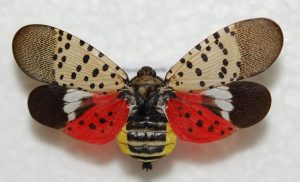
Despite its name, the Spotted Lanternfly is actually a species of leafhopper rather than a fly.
The problem, according to agricultural entomologists at Penn State University is “…it’s not uncommon to find trees covered with thousands of the flies all feeding at once…the trees simply get overwhelmed by the insects…”. According to a farmworker in Lancaster County PA, “This Summer the crops were just covered with the bugs”.
Since the insects are known to feed on over 70 species of plants most notably including, peach, apple, pear, walnut, oak, maple, and grape, the pests could signal disaster for many of the state’s orchards. While, information regarding the extent of damages are unavailable, it is estimated mortality rates for grape vines infested with the pest’s range between 95% and 98%. This has the state’s department of agriculture warning “They [Spotted Lanternfly] threaten billions of economic impacts and hundreds of thousands of jobs for those in the grape, apple, hops, and hardwood industries”.
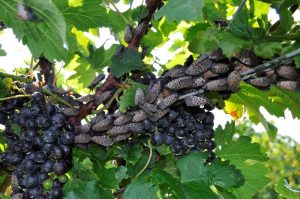
Above a swarm of Spotted Lanternflies can be seen feeding on a grape vine crop in a vineyard in southern New Jersey.
In 2016, NJ produced around 2 million gallons of wine, worth a retail value of approximately $30 million. The increasing encroachment of the Lanternfly however, threaten to put these profits at risk.
Despite being poor flyers, Lanternflies continue to expand their range by hitchhiking on agricultural products and debris traded across state and county lines. To combat this, officials at the NJ Department of Agriculture encourage individuals who frequently travel large distances to comply with the states quarantine rules and check vehicles and debris for the insects.
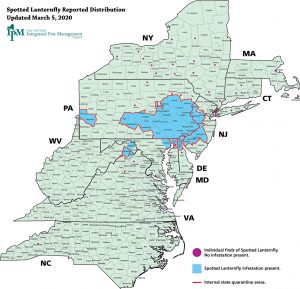
The map above shows the counties under quarantine as a result of the Spotted Lanternfly. As of now 6 states have counties under quarantine, but that is expected to increase as the insect continues to expand its range. (map courtesy of NJDA).
If the Spotted Lanternfly is found on your property, by state law you are required to contact the proper state officials for treatment options. Treatments can include the physical removal of the insects and their eggs and larvae by hand, or more drastic measures such as controlled burnings and use of chemical pesticides.
While some of these measures may seem extreme, according to insect specialists referred to as entomologist and NJDA officials they’re not without good reason. The Insects are able to multiply quickly by laying egg masses on host vegetation that consists of 30-50 eggs each. “This is bad news… Kill it! Squash it, smash it…just get rid of it. These are called bad bugs for a reason, don’t let them take over your county next” says an official from the PA Department of Agriculture.
While some methods of treatment such as the use of controlled burnings have proven effective against the insect, the treatment brings concerns over air quality and focuses on too small an area to halt the epidemic as a whole.
Other methods, such as the application of insecticides, manage to kill the insects in large numbers but remain harmful to people and beneficial insects, such as pollinators. According to plant ecologist Carol Loeffler, it’s illegal to use insecticides to kill the invading insects since they’re yet to be listed on pesticide labels. Loeffler explains that “the insects are so new to America, that pesticide labels have yet to include them”.
Loeffler has concerns that the situation is getting out of hand and worries farmers are starting to “…just spray with whatever pesticide they think would work. They can’t afford to worry about whether or not the bug is listed on the label” says Carol Loeffler.
While Loeffler is optimistic a solution will arise, the lifelong plant enthusiast has worries that the “Lanternfly is emblematic of a “new wave of pests” that could put some farmers out of business.
Nevertheless, agricultural experts across the country are working tirelessly to find a solution. Recent studies by entomologists at Penn State University at College Park, have shown a correlation between Lanternfly populations and the population of an invasive tree called “Tree of Heaven” or Ailanthus. The invasive tree is native to China, and overlaps with the native range of the Spotted Lanternfly. In its native habitat, Ailanthus acts as a host plant for the Spotted Lanternfly which will often lay its eggs on the trees bark and leaves.
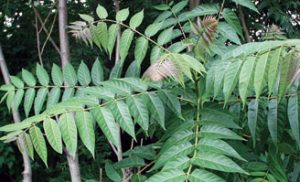
Tree of Heaven, such as the one pictured above, are commonly seen growing along roadsides and fencerows, and are considered an exotic invader in their own right.
In the U.S, Ailanthus can commonly be found growing along cropland, roadsides, and any disturbed habitats. Scientist believe the same relationship observed between Ailanthus and the Spotted Lanternfly in Southeast Asia also holds true in the United States. The studies suggest, that by removing the invasive Ailanthus, counties can decrease Spotted Lanternfly populations and mitigate their spread.
Already, counties in central Pennsylvania and New Jersey are taking the studies advice, and have put programs in motion to remove the invasive trees. So far, it’s too early to tell whether the tactic will work. Documents from the NJDA suggests the insects are highly adaptable and will find another host. Regardless, the Tug of war between man and insect continues to persist, and the fate of the state’s orchard and timber industries, as well as the livelihoods of thousands remain at risk.
References:
Urban, M., J. 2020. Perspective: shedding light on Spotted Lanternfly impacts in the USA. Pest Management Science 10-17.
Spotted Lanternfly: Research Update. Penn State Extension. 2020. https://extension.psu.edu/spotted-lanternfly-research-update.
Spotted Lanternfly. Pennsylvania Department of Agriculture. 2020. https://www.agriculture.pa.gov/Plants_Land_Water/PlantIndustry/Entomology/spotted_lanternfly/Pages/default.aspx.
Wolfe, J. 2020. Department of Agriculture: Spotted Lanternfly. https://www.nj.gov/agriculture/divisions/pi/prog/spottedlanternfly.html.
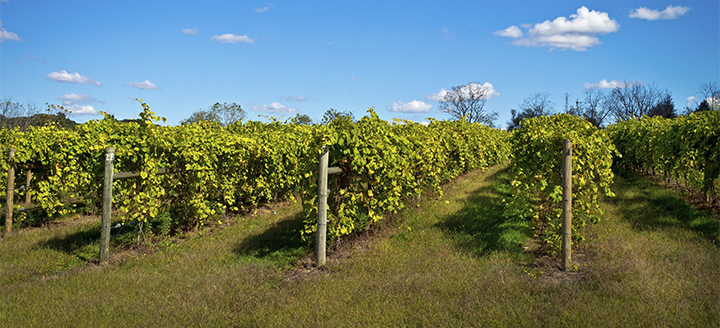
Alex
"This title was very eye catching! That is so interesting that such a ..."
Alex
"This is really interesting! The fact that crops and plants are damaged is ..."
Alex
"Well done, this article is great and the information is very captivating! Ethics ..."
Alex
"I was intrigued throughout the whole article! This is such an interesting topic, ..."
Alex
"This is such an interesting article, and very relevant!! Great job at explaining ..."
Grandpa
"Honey You Did a good job I will forward to my eye doctor "
murphymv
"This article is fascinating because it delves into the details of the research ..."
murphymv
"I agree, adding the photo helped solidify the main finding. "
murphymv
"This is a fascinating finding. I hope this innovative approach to improving transplants ..."
Sherzilla
"This is a great article! I would really love to hear how exactly ..."
Sherzilla
"It's disappointment that these treatments were not very effective but hopefully other researchers ..."
Sherzilla
"I agree with your idea that we need to shift our focus to ..."
Sherzilla
"It's amazing to see how such an everyday household product such as ..."
Lauren Kageler
"I will be interested to see what the data looks like from the ..."
Lauren Kageler
"A very interesting article that emphasizes one of the many benefits that the ..."
maricha
"Great post! I had known about the plight of Little Browns, but I ..."
Sherzilla
"I assumed cancer patients were more at risk to the virus but I ..."
Sherzilla
"Great article! It sheds light on a topic that everyone is curious about. ..."
maricha
"This article is full of really important and relevant information! I really liked ..."
maricha
"Definitely a very newsworthy article! Nice job explaining the structure of the virus ..."
maricha
"It's interesting to think that humans aren't only species dealing with the global ..."
murphymv
"This is very interesting and well explained. I am not too familiar with ..."
Lauren Kageler
"Great article! This post is sure to be a useful resource for any ..."
Lauren Kageler
"Definitely seems like an odd pairing at first, but any step forward in ..."
murphymv
"What an interesting article! As you say, height and dementia seem unrelated at ..."
murphymv
"Great article! I learned several new methods of wildlife tracking. This seems like ..."
murphymv
"Very interesting topic! You explained cascade testing and its importance very well. I ..."
Alex
"This article is really interesting! What got me hooked right away was the ..."
Sabrina
"I found this article super interesting! It’s crazy how everyday products can cause ..."
Erin Heeschen
"I love the layout of this article; it's very eyecatching! The advancements of prosthetics ..."
murphymv
"Awesome article! I like the personality in the writing. Flash Graphene not only ..."
murphymv
"Very interesting work! I don't know a whole lot about genetics, but this ..."
Cami Meckley
"I think the idea of using virtual reality technology to better help prepare ..."
Erin Heeschen
"I wonder if there's a connection between tourist season and wildfires in the ..."
Ralph berezan
"Not bad Good work "
Michelle
"This sounds like it would be a great tool for medical students! ..."